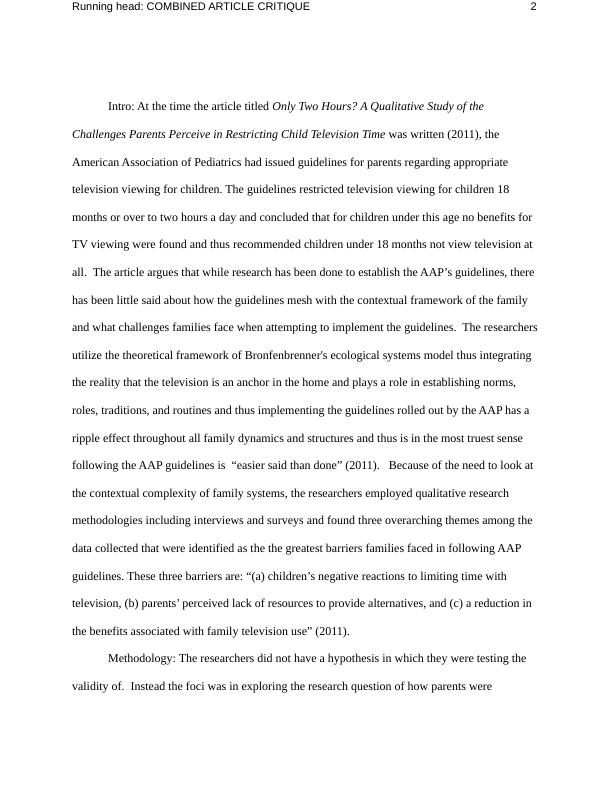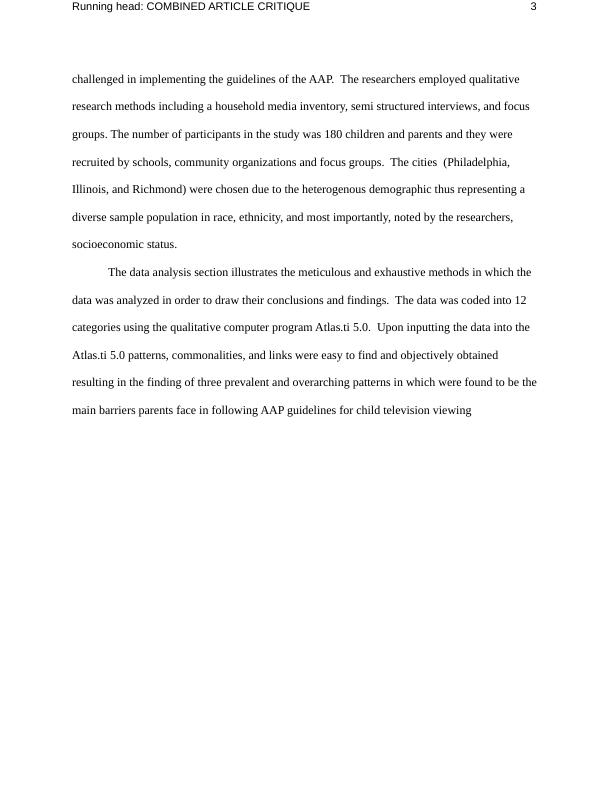Challenges Parents Face in Restricting Child Television Time and Childhood Obesity: A Quantitative Study
Added on 2023-06-10
6 Pages1330 Words345 Views
Running head: COMBINED ARTICLE CRITIQUE 1
Combined Articles Critique
Katie Liljedahl
University of Colorado 2018
Combined Articles Critique
Katie Liljedahl
University of Colorado 2018

Running head: COMBINED ARTICLE CRITIQUE 2
Intro: At the time the article titled Only Two Hours? A Qualitative Study of the
Challenges Parents Perceive in Restricting Child Television Time was written (2011), the
American Association of Pediatrics had issued guidelines for parents regarding appropriate
television viewing for children. The guidelines restricted television viewing for children 18
months or over to two hours a day and concluded that for children under this age no benefits for
TV viewing were found and thus recommended children under 18 months not view television at
all. The article argues that while research has been done to establish the AAP’s guidelines, there
has been little said about how the guidelines mesh with the contextual framework of the family
and what challenges families face when attempting to implement the guidelines. The researchers
utilize the theoretical framework of Bronfenbrenner's ecological systems model thus integrating
the reality that the television is an anchor in the home and plays a role in establishing norms,
roles, traditions, and routines and thus implementing the guidelines rolled out by the AAP has a
ripple effect throughout all family dynamics and structures and thus is in the most truest sense
following the AAP guidelines is “easier said than done” (2011). Because of the need to look at
the contextual complexity of family systems, the researchers employed qualitative research
methodologies including interviews and surveys and found three overarching themes among the
data collected that were identified as the the greatest barriers families faced in following AAP
guidelines. These three barriers are: “(a) children’s negative reactions to limiting time with
television, (b) parents’ perceived lack of resources to provide alternatives, and (c) a reduction in
the benefits associated with family television use” (2011).
Methodology: The researchers did not have a hypothesis in which they were testing the
validity of. Instead the foci was in exploring the research question of how parents were
Intro: At the time the article titled Only Two Hours? A Qualitative Study of the
Challenges Parents Perceive in Restricting Child Television Time was written (2011), the
American Association of Pediatrics had issued guidelines for parents regarding appropriate
television viewing for children. The guidelines restricted television viewing for children 18
months or over to two hours a day and concluded that for children under this age no benefits for
TV viewing were found and thus recommended children under 18 months not view television at
all. The article argues that while research has been done to establish the AAP’s guidelines, there
has been little said about how the guidelines mesh with the contextual framework of the family
and what challenges families face when attempting to implement the guidelines. The researchers
utilize the theoretical framework of Bronfenbrenner's ecological systems model thus integrating
the reality that the television is an anchor in the home and plays a role in establishing norms,
roles, traditions, and routines and thus implementing the guidelines rolled out by the AAP has a
ripple effect throughout all family dynamics and structures and thus is in the most truest sense
following the AAP guidelines is “easier said than done” (2011). Because of the need to look at
the contextual complexity of family systems, the researchers employed qualitative research
methodologies including interviews and surveys and found three overarching themes among the
data collected that were identified as the the greatest barriers families faced in following AAP
guidelines. These three barriers are: “(a) children’s negative reactions to limiting time with
television, (b) parents’ perceived lack of resources to provide alternatives, and (c) a reduction in
the benefits associated with family television use” (2011).
Methodology: The researchers did not have a hypothesis in which they were testing the
validity of. Instead the foci was in exploring the research question of how parents were

Running head: COMBINED ARTICLE CRITIQUE 3
challenged in implementing the guidelines of the AAP. The researchers employed qualitative
research methods including a household media inventory, semi structured interviews, and focus
groups. The number of participants in the study was 180 children and parents and they were
recruited by schools, community organizations and focus groups. The cities (Philadelphia,
Illinois, and Richmond) were chosen due to the heterogenous demographic thus representing a
diverse sample population in race, ethnicity, and most importantly, noted by the researchers,
socioeconomic status.
The data analysis section illustrates the meticulous and exhaustive methods in which the
data was analyzed in order to draw their conclusions and findings. The data was coded into 12
categories using the qualitative computer program Atlas.ti 5.0. Upon inputting the data into the
Atlas.ti 5.0 patterns, commonalities, and links were easy to find and objectively obtained
resulting in the finding of three prevalent and overarching patterns in which were found to be the
main barriers parents face in following AAP guidelines for child television viewing
challenged in implementing the guidelines of the AAP. The researchers employed qualitative
research methods including a household media inventory, semi structured interviews, and focus
groups. The number of participants in the study was 180 children and parents and they were
recruited by schools, community organizations and focus groups. The cities (Philadelphia,
Illinois, and Richmond) were chosen due to the heterogenous demographic thus representing a
diverse sample population in race, ethnicity, and most importantly, noted by the researchers,
socioeconomic status.
The data analysis section illustrates the meticulous and exhaustive methods in which the
data was analyzed in order to draw their conclusions and findings. The data was coded into 12
categories using the qualitative computer program Atlas.ti 5.0. Upon inputting the data into the
Atlas.ti 5.0 patterns, commonalities, and links were easy to find and objectively obtained
resulting in the finding of three prevalent and overarching patterns in which were found to be the
main barriers parents face in following AAP guidelines for child television viewing

End of preview
Want to access all the pages? Upload your documents or become a member.
Related Documents
Quantitative and Qualitative Critique Assignment Samplelg...
|6
|1144
|545
Parent Child Relationship in Middle Childhoodlg...
|8
|1645
|23
Critical Review of Quantitative Study on Childhood Obesitylg...
|5
|1113
|299
Social Science Survey Assignment 2022lg...
|7
|2334
|12
